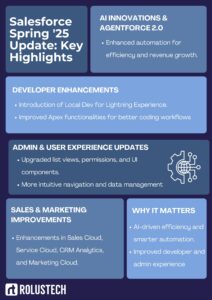Remember when AI felt like a futuristic dream? Well, Salesforce just made that future a reality with its Spring ’25 update bringing smarter automation, better tools, and a whole new way to work.
Introducing a range of advancements designed to enhance AI capabilities, developer tools, and user experience, this update follows Salesforce’s regular release cycle, ensuring businesses stay ahead with cutting-edge digital transformation.
With AI becoming a focal point in enterprise solutions, the emergence of AI agents like Agentforce highlights Salesforce’s commitment to intelligent automation. This release is expected to enhance productivity, improve system efficiencies, and streamline operations for users across different roles.
Key Updates
The Salesforce Spring ’25 Update brings a host of innovations designed to enhance AI capabilities, developer tools, admin functionalities, sales and marketing processes, and security measures.
Agentforce 2.0 takes AI-driven automation to the next level, improving operational efficiency and revenue potential. Developers benefit from new tools like Local Dev for Lightning Experience and Apex enhancements, streamlining workflows.
Admins and users will notice improvements in list views, permissions, and UI components, making navigation more intuitive. Meanwhile, updates to Sales Cloud, Service Cloud, and Marketing Cloud refine customer engagement strategies.
Additionally, process automation gets a boost with real-time validation in Salesforce Flows, alongside strengthened security features for better authentication and access control.
AI Innovations & Agentforce
Agentforce 2.0 introduces a more advanced AI-driven approach to sales and service automation. Positioned as a “digital labor” assistant, it is designed to streamline workflows, automate repetitive tasks, and assist sales and service professionals in real time.
Analysts predict that the integration of AI into Salesforce workflows will drive a measurable increase in productivity, with early forecasts suggesting a potential 1% revenue uplift. These advancements reflect a broader industry shift toward AI-powered enterprise solutions that prioritize efficiency and data-driven decision-making.
Developer Enhancements
Salesforce continues to improve the developer experience with several key updates:
- Local Development Improvements: The introduction of hot reloading for Lightning Experience enables developers to test changes instantly without lengthy refresh times, significantly improving development speed.
- UI and Component Upgrades: The transition from Aura to Lightning Web Components (LWC) for list views and related lists modernizes the UI, improving performance and maintainability.
- Apex and Code Optimization: Apex enhancements, including new compression functions (Compression.ZipWriter) and dynamic formula evaluation, provide developers with greater flexibility and performance efficiency.
- Other Tools & Updates: Additional refinements in Salesforce CLI, VS Code extensions, and debugging tools simplify the development workflow, improving the overall efficiency of coding and deployment processes.
Administrator and User Management Enhancements
For administrators, various improvements streamline data management, security, and customization options:
- Enhanced List and Related Lists: Users can now sort list views and related lists across multiple columns, improving data organization and accessibility.
- User Permissions and Setup: Permissions are renamed for clarity, with “View All” becoming “View All Records” and the introduction of a new “View All Fields” permission for better data visibility management.
- Security and Compliance Updates: Email sender verification receives enhancements, password reset procedures are updated to increase security, and multi-factor authentication requirements are further reinforced to protect user access.
Sales and Service Cloud Enhancements
The Sales and Service Cloud updates focus on increasing automation and refining workflow management:
- Sales Action Plans & Account Plan Enhancements: Sales teams can now automate key objectives within account plans, improving tracking and strategic planning.
- Agentforce for Sales & Service: AI-driven sales coaching tools help sales development representatives (SDRs) qualify leads more effectively, while service teams benefit from AI-assisted case resolution tools that reduce response times.
- Forecasting and Quota Planning: New features for opportunity management and enhanced integration of quota planning with territory-based forecasting provide more accurate sales predictions and strategic insights.
Marketing and CRM Analytics Updates
Enhancements to CRM Analytics and Marketing Cloud improve reporting capabilities and campaign performance:
- CRM Analytics Improvements: Users can now refresh individual dashboard widgets, add multiple assets in bulk, and create more dynamic and customizable report types.
- Marketing Cloud and Account Engagement Enhancements: AI-powered multilingual content generation allows marketers to create globalized campaigns more efficiently. Improved email send tracking provides greater visibility into delivery rates and potential failures.
Salesforce Flows and Process Automation
Process automation improvements enhance the efficiency of approval workflows and user interactions:
- Flow Enhancements for End Users: Immediate error feedback and real-time input validation reduce form submission errors and improve overall user experience.
- Flow Management and Approval Process Updates: New orchestration tools streamline complex approval workflows, making them easier to manage while reducing the likelihood of bottlenecks.
Infrastructure and Platform-Level Updates
Salesforce enhances its core infrastructure and platform to support better scalability and performance:
- Hyperforce, CDN, and Salesforce Connect: The shift from Akamai to CloudFront improves content delivery speeds, while changes to Hyperforce outbound IP lists ensure more stable network connections.
- Platform and Product Retirements: Salesforce is phasing out legacy API versions, instance-based domain names, and Salesforce Functions, requiring businesses to plan for migrations and updates accordingly.
Market and Revenue Impact Analysis
 The Spring ’25 update has received significant attention from analysts and investors, particularly regarding its AI-driven automation features. Market expectations suggest that Agentforce alone could contribute to a 1% revenue increase, a significant figure given
The Spring ’25 update has received significant attention from analysts and investors, particularly regarding its AI-driven automation features. Market expectations suggest that Agentforce alone could contribute to a 1% revenue increase, a significant figure given
Salesforce’s enterprise scale. AI monetization remains a key challenge, with adoption rates varying across industries. However, Salesforce’s long-term strategy positions the company for sustained growth, with projections indicating potential mid-teen revenue growth by 2027.
The update solidifies Salesforce’s role as a leader in AI-driven enterprise solutions, setting the stage for future innovations in intelligent automation and process optimization.
Strategic Takeaways and Future Considerations
Salesforce’s Spring ’25 update brings valuable enhancements for various stakeholders. Developers can take advantage of more efficient coding tools, while administrators benefit from improved security and management options.
Sales and marketing teams, on the other hand, will see significant gains from AI-powered automation, helping streamline processes and boost productivity.
Looking to leverage the full potential of Salesforce’s Spring ’25 features? Explore how Rolustech’s Salesforce services can assist with implementation and customization
Migration planning is also essential, especially for deprecated features that require adjustments. As Salesforce continues to push the boundaries of AI and digital transformation, organizations that stay ahead of these innovations will gain a competitive edge in an increasingly automated business landscape.
Conclusion
The Spring ’25 update demonstrates Salesforce’s ongoing commitment to innovation through AI, enhanced development tools, and improved user experiences. From sales automation to infrastructure upgrades, the release introduces features designed to drive efficiency and long-term growth.
Businesses should take proactive steps to implement these updates, ensuring they maximize their benefits. As AI continues to shape enterprise software, Salesforce’s leadership in the field remains undisputed, making it a key player in the future of digital transformation.




